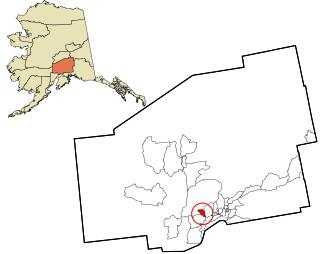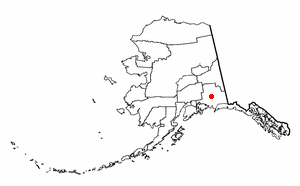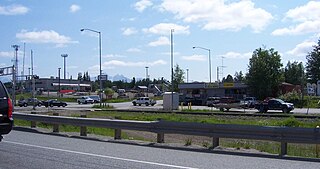
Matanuska-Susitna Borough is a borough located in the U.S. state of Alaska. Its borough seat is Palmer, and the largest community is the census-designated place of Knik-Fairview. As of the 2020 census, the borough's population was 107,801.

Houston is a city in Matanuska-Susitna Borough, Alaska, United States. It is part of the Anchorage, Alaska Metropolitan Statistical Area. It is located roughly 33 miles from downtown Anchorage, though it is a 57-mile drive between the two points. The population was 1,975 at the 2020 census, up from 1,912 in 2000.

Knik River is a census-designated place (CDP) in Matanuska-Susitna Borough in the U.S. state of Alaska. Located 15 miles southeast from Palmer along the Knik River, it is part of the Anchorage, Alaska Metropolitan Statistical Area. The population was 792 at the 2020 census, up from 744 in 2010.

Lazy Mountain is a census-designated place (CDP) in Matanuska-Susitna Borough, Alaska, United States. Located east of Palmer along the Matanuska River. At the 2020 census the population was 1,506, up from 1,479 in 2010.

Palmer is a city in and the borough seat of the Matanuska-Susitna Borough, Alaska, United States, located 42 miles (68 km) northeast of Anchorage on the Glenn Highway in the Matanuska Valley. It is the ninth-largest city in Alaska, and forms part of the Anchorage Metropolitan Statistical Area. As of the 2020 census, the population of the city is 5,888, down from 5,937 in 2010.

Susitna North is a census-designated place (CDP) in the Matanuska-Susitna Borough in the U.S. state of Alaska. It is part of the Anchorage, Alaska Metropolitan Statistical Area. The population was 1,564 at the 2020 census, up from 1,260 in 2010. The CDP was formerly named Y, for the intersection of the George Parks Highway and the Talkeetna Spur Road. In the immediate vicinity of this intersection is a community center, containing a health clinic, law enforcement, Susitna Valley High School, and retail services for highway travelers such as gasoline and food.

Gakona is a census-designated place (CDP) in the Copper River Census Area in the U.S. state of Alaska. As of the 2020 census, the population of the CDP was 169, down from 218 in 2010. It is home to the High-frequency Active Auroral Research Program.

Glennallen is a census-designated place (CDP) in the Copper River Census Area in the Unorganized Borough of the U.S. state of Alaska. As of the 2020 census, the population of the CDP was 439, down from 483 in 2010. It is the most populated community in the census area.
The Glenn Highway is a highway in the U.S. state of Alaska, extending 179 miles (288 km) from Anchorage near Merrill Field to Glennallen on the Richardson Highway. The Tok Cut-Off is often considered part of the Glenn Highway, for a total length of 328 miles (528 km).

Chugiak is an unincorporated community in the Municipality of Anchorage in the U.S. state of Alaska, situated approximately 20 miles (32 km) northeast of downtown Anchorage.

Eagle River is a community within the Municipality of Anchorage situated on the Eagle River, for which it is named, between Joint Base Elmendorf-Richardson (JBER) and Chugach State Park in the Chugach Mountains. Its ZIP code is 99577. Settled by homesteaders, Eagle River has been annexed to the Municipality of Anchorage since the 1970s—a relationship that is, at times, complicated. On the one hand, Eagle River functions as an Anchorage suburb--many Eagle River residents work, shop, and participate in community life in the Anchorage Bowl. On the other hand, the community is itself a significant business hub between Wasilla and Anchorage, offering shopping, restaurants, recreation and employment. Much of the community is made up of residents from nearby Joint Base Elmendorf-Richardson. Secession efforts have from time to time gained traction by residents who would like Eagle River legally regarded as a separate community. Eagle River also has a close relationship with its neighboring community to the north, Chugiak, with which it shares some history. If Eagle River were not part of the Municipality of Anchorage, it would be classified as one of the five largest cities in Alaska.

KMBQ-FM is a radio station broadcasting a modern adult contemporary format. Licensed to Wasilla, Alaska, United States, the station serves the Mat-Su Valley area. The station is currently owned by Seattle-based Ohana Media Group. Its studios are located in Downtown Anchorage and its transmitter is north of Wasilla.
Kenner Army Health Clinic – formerly Kenner Army Community Hospital – is the primary health care facility for Fort Gregg-Adams, Virginia.

Wasilla High School (WHS) is a public secondary school in Wasilla, Alaska, United States, serving students in grades 9–12. The school is part of the Matanuska-Susitna Borough School District, with admission based primarily on the locations of students' homes.

Wasilla (Dena'ina: Benteh) is a city in Matanuska-Susitna Borough, Alaska, United States, and the fourth-largest city in Alaska. It is located on the northern point of Cook Inlet in the Matanuska-Susitna Valley of the southcentral part of the state. The city's population was 9,054 at the 2020 census, up from 7,831 in 2010. Wasilla is the largest city in the borough and a part of the Anchorage metropolitan area, which had an estimated population of 398,328 in 2020.

Kaweah Health Medical Center is located in Visalia, California, United States and offers comprehensive health services including cardiac, vascular, colorectal, and general surgery, neurosurgery, oncology, mental health services, orthopedic surgery, adult and neonatal intensive care and pediatrics, and more. It is the largest hospital in Tulare County and Kings County, serving a population of more than 600,000. Kaweah Health is governed by an elected board of directors.

Matanuska-Susitna Valley is an area in Southcentral Alaska south of the Alaska Range about 35 miles (56 km) north of Anchorage, Alaska. It is known for the world record sized cabbages and other vegetables displayed annually in Palmer at the Alaska State Fair. It includes the valleys of the Matanuska, Knik, and Susitna Rivers. 11,000 of Mat-Su Valley residents commute to Anchorage for work . It is the fastest growing region in Alaska and includes the towns of Palmer, Wasilla, Big Lake, Houston, Willow, Sutton, and Talkeetna. The Matanuska-Susitna Valley is primarily the land of the Dena'ina and Ahtna Athabaskan people.

Tikahtnu Commons is a 900,000 square foot power center located on a 95-acre parcel in Anchorage, Alaska, United States. It is owned by Cook Inlet Region, Inc., an Alaska Native corporation and Browman Development Company, a California corporation. The shopping center consists of several large anchor stores, dozens of smaller restaurants, shops and services, and a 16-screen Regal Cinemas theater. Tikahtnu is the word for Cook Inlet in the Dena'ina language. Tikahtnu Commons is home to many firsts for Alaska, including the state's first Kohl's, PetSmart and IMAX theater. It is the largest shopping center in the state and is even large by national comparison. The International Council of Shopping Centers states that power centers in the United States typically range from 250,000 to 600,000 square feet with an average of 420,160 square feet (39,034 m2). Construction of the center began in 2007 and by the summer of 2015, it had been developed to roughly 98% capacity. Anchors include Lowes, Old Navy, Petsmart, Kohls, Burlington, Target, Best Buy, Regal Cinemas, and Costco.

Fairview is a neighborhood in Anchorage, Alaska just east of Downtown Anchorage and west of the Merrill Field Airport. The area is a working-class neighborhood of approximately 7,200 residents, with a median household income of approximately $55,000 and a poverty rate of approximately 21%.


















